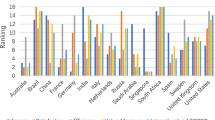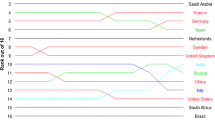Abstract
In practice, a variety of composite indicators are created using the arithmetic average of different sub-indicators. However, this scheme is typically criticized of the possibility of compensation. For this reason, this paper re-constructs these composite indicators by means of a new methodology. Comprehensive individual judgements among the sub-indicators have been considered to determine the maximum total utilities. Then the best–worst method is introduced to determine the preference associated with various individual judgements. An illustration of Value Measure of health systems is presented to demonstrate the validity and usefulness of our methodology.
Similar content being viewed by others
References
Areal, F. J., & Riesgo, L. (2015). Probability functions to build composite indicators: A methodology to measure environmental impacts of genetically modified crops. Ecological Indicators, 52, 498–516.
Badea, A. C., Claudio, M. R. S., Tarantola, S., & Bolado, R. (2011). Composite indicators for security of energy supply using ordered weighted averaging. Reliability Engineering & System Safety, 96(6), 651–662.
Barron, F. H., & Barrett, B. E. (1996). Decision quality using ranked attribute weights. Management Science, 42(11), 1515–1523.
Becker, W., Saisana, M., Paruolo, P., & Vandecasteele, I. (2017). Weights and importance in composite indicators: Closing the gap. Ecological Indicators, 80, 12–22.
Bordley, R. F. (1982). A multiplicative formula for aggregating probability assessments. Management Science, 28(10), 1137–1148.
Cherchye, L., Moesen, W., Rogge, N., & Van Puyenbroeck, T. (2007). An introduction to ‘benefit of the doubt’ composite indicators. Social Indicators Research, 82(1), 111–145.
Cherchye, L., Moesen, W., Rogge, N., Van Puyenbroeck, T., Saisana, M., Saltelli, A., et al. (2008). Creating composite indicators with DEA and robustness analysis: The case of the Technology Achievement Index. Journal of the Operational Research Society, 59(2), 239–251.
Claveria, O., Monte, E., & Torra, S. (2018). A data-driven approach to construct survey-based indicators by means of evolutionary algorithms. Social Indicators Research, 135(1), 1–14.
Ding, Y., Fu, Y., Lai, K. K., & Leung, W. J. (2018). Using ranked weights and acceptability analysis to construct composite indicators: A case study of regional sustainable society index. Social Indicators Research, 139(3), 871–885.
Ebert, U., & Welsch, H. (2004). Meaningful environmental indices: A social choice approach. Journal of Environmental Economics and Management, 47(2), 270–283.
Fusco, E. (2015). Enhancing non-compensatory composite indicators: A directional proposal. European Journal of Operational Research, 242(2), 620–630.
Gnaldi, M., & Del Sarto, S. (2018). Variable weighting via multidimensional IRT models in composite indicators construction. Social Indicators Research, 136(3), 1139–1156.
Hatefi, S., & Torabi, S. (2010). A common weight MCDA-DEA approach to construct composite indicators. Ecological Economics, 70(1), 114–120.
Hochbaum, D. S., & Levin, A. (2006). Methodologies and algorithms for group-rankings decision. Management Science, 52(9), 1394–1408.
Karagiannis, G. (2017). On aggregate composite indicators. Journal of the Operational Research Society, 68(7), 741–746.
Lauro, N. C., Grassia, M. G., & Cataldo, R. (2018). Model based composite indicators: New developments in partial least squares-path modeling for the building of different types of composite indicators. Social Indicators Research, 135(2), 421–455.
Lee, S., & Yu, J. (2013). Composite indicator development using utility function and fuzzy theory. Journal of the Operational Research Society, 64(8), 1279–1290.
Luzzati, T., & Gucciardi, G. (2015). A non-simplistic approach to composite indicators and rankings: An illustration by comparing the sustainability of the EU countries. Ecological Economics, 113, 25–38.
Morris, P. A. (1977). Combining expert judgments: A Bayesian approach. Management Science, 23(7), 679–693.
Munda, G. (2012). Choosing aggregation rules for composite indicators. Social Indicators Research, 109(3), 337–354.
Munda, G., & Nardo, M. (2009). Noncompensatory/nonlinear composite indicators for ranking countries: A defensible setting. Applied Economics, 41(12), 1513–1523.
Nardo, M., Saisana, M., Saltelli, A., Tarantola, S., Hoffman, A., & Giovannini, E. (2005). Handbook on constructing composite indicators. Paris: OECD Publishing.
Peng, C., Wu, X., Fu, Y., & Lai, K. K. (2017). Alternative approaches to constructing composite indicators: An application to construct a sustainable energy index for APEC economies. Operational Research, 17(3), 747–759.
Rezaei, J. (2015). Best–worst multi-criteria decision-making method. Omega, 53, 49–57.
Rezaei, J. (2016). Best–worst multi-criteria decision-making method: Some properties and a linear model. Omega, 64, 126–130.
Rogge, N. (2018). On aggregating benefit of the doubt composite indicators. European Journal of Operational Research, 264(1), 364–369.
Rogge, N., & Van Nijverseel, I. (2018). Quality of life in the European Union: A multidimensional analysis. Social Indicators Research, 141(2), 765–789. https://doi.org/10.1007/s11205-018-1854-y.
Saaty, T. L. (1986). Axiomatic foundation of the analytic hierarchy process. Management Science, 32(7), 841–855.
Saisana, M., & Tarantola, S. (2002). State-of-the-art report on current methodologies and practices for composite indicator development. European Commission, Joint Research Centre.
Saltelli, A. (2007). Composite indicators between analysis and advocacy. Social Indicators Research, 81(1), 65–77.
Shen, Y., Hermans, E., Brijs, T., & Wets, G. (2013). Data envelopment analysis for composite indicators: A multiple layer model. Social Indicators Research, 114(2), 739–756.
Song, L., & Liu, F. (2018). An improvement in DEA cross-efficiency aggregation based on the Shannon entropy. International Transactions in Operational Research, 25(2), 705–714.
Song, L., Fu, Y., Zhou, P., & Lai, K. K. (2017). Measuring national energy performance via energy trilemma index: A stochastic multicriteria acceptability analysis. Energy Economics, 66, 313–319.
Van Puyenbroeck, T., & Rogge, N. (2017). Geometric mean quantity index numbers with Benefit-of-the-Doubt weights. European Journal of Operational Research, 256(3), 1004–1014.
Verbunt, P., & Rogge, N. (2018). Geometric composite indicators with compromise Benefit-of-the-Doubt weights. European Journal of Operational Research, 264(1), 388–401.
Wang, H. (2015). A generalized MCDA-DEA (multi-criterion decision analysis-data envelopment analysis) approach to construct slacks-based composite indicator. Energy, 80, 114–122.
Wu, S., Fu, Y., Shen, H., & Liu, F. (2018). Using ranked weights and Shannon entropy to modify regional sustainable society index. Sustainable cities and society, 41, 443–448.
Yakowitz, D., Lane, L., & Szidarovszky, F. (1993). Multi-attribute decision making: dominance with respect to an importance order of the attributes. Applied Mathematics and Computation, 54(2–3), 167–181.
Zhang, L., & Zhou, P. (2018). A non-compensatory composite indicator approach to assessing low-carbon performance. European Journal of Operational Research, 270(1), 352–361.
Zhou, P., Delmas, M., & Kohli, A. (2017). Constructing meaningful environmental indices: A nonparametric frontier approach. Journal of Environmental Economics and Management, 85, 21–34.
Zhou, P., & Ang, B. (2009). Comparing MCDA aggregation methods in constructing composite indicators using the Shannon-Spearman measure. Social Indicators Research, 94(1), 83–96.
Zhou, P., Ang, B., & Poh, K. (2006). Comparing aggregating methods for constructing the composite environmental index: An objective measure. Ecological Economics, 59(3), 305–311.
Zhou, P., Ang, B., & Poh, K. (2007). A mathematical programming approach to constructing composite indicators. Ecological Economics, 62(2), 291–297.
Zhou, P., Ang, B., & Zhou, D. (2010). Weighting and aggregation in composite indicator construction: A multiplicative optimization approach. Social Indicators Research, 96(1), 169–181.
Author information
Authors and Affiliations
Corresponding author
Additional information
Publisher's Note
Springer Nature remains neutral with regard to jurisdictional claims in published maps and institutional affiliations.
Rights and permissions
About this article
Cite this article
Wang, T., Fu, Y. Constructing Composite Indicators with Individual Judgements and Best–Worst Method: An Illustration of Value Measure. Soc Indic Res 149, 1–14 (2020). https://doi.org/10.1007/s11205-019-02236-3
Accepted:
Published:
Issue Date:
DOI: https://doi.org/10.1007/s11205-019-02236-3




